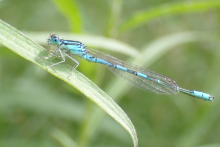Last year Flores Magon and her husband Oscar Enriquez, a PhD candidate in the Physics of Complex Fluids group at the UT, decided to move from Mexico City to Twente so he could pursue his studies. ‘At that time,’ she said while we sat amongst her Alebrijes on display in the Spiegel, ‘I had to start imagining my new life in the Netherlands. And it was then, for the first time, that I could think of myself as a real artist.’
 |
| Flores Magon’s work is inspired by artists from her native Mexico: painters Frida Kahlo and Diego Rivera and engraver and illustrator Guadalupe Posada. (Photo: Gijs van Ouwerkerk) |
Envisioning her move as an opportunity to pursue her artwork, Flores Magon now works eight hours a day building and painting her fantastical creatures. Alebrijes are sculpted from wire and cardboard and meticulously painted with highly-detailed patterns and motifs. The colors are vibrant and alive even though the Alebrijes often represent something quite dead!
Skeletons are a favorite subject and they reflect the way Mexicans honor their ancestors on November 1 and 2. The Day of the Dead is a national holiday when Mexicans make shrines and decorate their ancestors’ graves with flowers and offerings of food and drink. Skeletons and skulls abound, both as sweets and breads, and these, as well as, small demons, dragons, and fantastic animals are common Alebrijes.
Animated skeletons may be an acquired taste, however, for her Dutch audience. ‘My Dutch teacher came to see my work and said, “Why, they are dead!”’ Flores Magon smiled a small apology. ‘But it’s quite normal for us to see skeletons everywhere. We always honor the dead. After all, death is behind you and death is in front of you.’ Her Alebrije skeletons, paradoxically, are full of life. Two are dancing flamenco together, their hands arched to silent guitar music, another is a mermaid wearing a fish as a queenly crown, and another skeleton mermaid sheds snake-like tears.
Alebrijes were invented by Pedro Linares who at the time was severely ill and imagined these strange animals during feverish hallucinations and dreams. He felt that these daemons acted as kind and loyal guardians and helped him recover. After his recuperation in 1930, he started to create these elaborate decorative pieces. Twelve years ago, she started to work with Alebrijes as a hobby, ‘Now, it’s my way of life,’ she said.
This is not said lightly, as Flores Magon has already been many things in her life. She has a B.S. in Biology from the Science Faculty of the National Autonomous University of Mexico and spent seven years as a high school biology teacher. During her time as a teacher, she also studied painting and earned a masters degree in Visual Art at the Hellenic Cultural Institute in Mexico City.
Flores Magon also worked as a professional flamenco dancer. She now performs traditional Mexican music called son jarocho which is a fusion of indigenous, Spanish, and African musical elements, reflecting the population which evolved in the Veracruz region from Spanish colonial times. You might have already caught her playing the small guitar called jarana and stomping out zapeteado steps to ‘La Bamba’ in the local band, Chilangos Habaneros, which includes her husband on percussions.
Flores Magon also loves to paint. ‘When I suddenly have an idea, I then draw it,’ she explained her creative process. ‘I am always thinking about what I can build next. One thing I don’t want to do is compete with other artists here in the Netherlands. Instead, I want to focus on and promote this traditional technique from Mexico.’
To experience Flores Magon’s Alebrijes, you now have to go to the ARTANA Latin American Fine Art Gallery in Den Haag www.artana.nl/content/welcome or visit www.danielafloresmagon.com. You can also catch her singing, playing jarana, and dancing on www.vimeo.com/9983061.
 |
| This piece called Sirena is make of paper on wood with oils. ‘She is a bit like me,’ admitted Flores Magon, ‘singing and playing the jarana.’ (Photo: private) |







